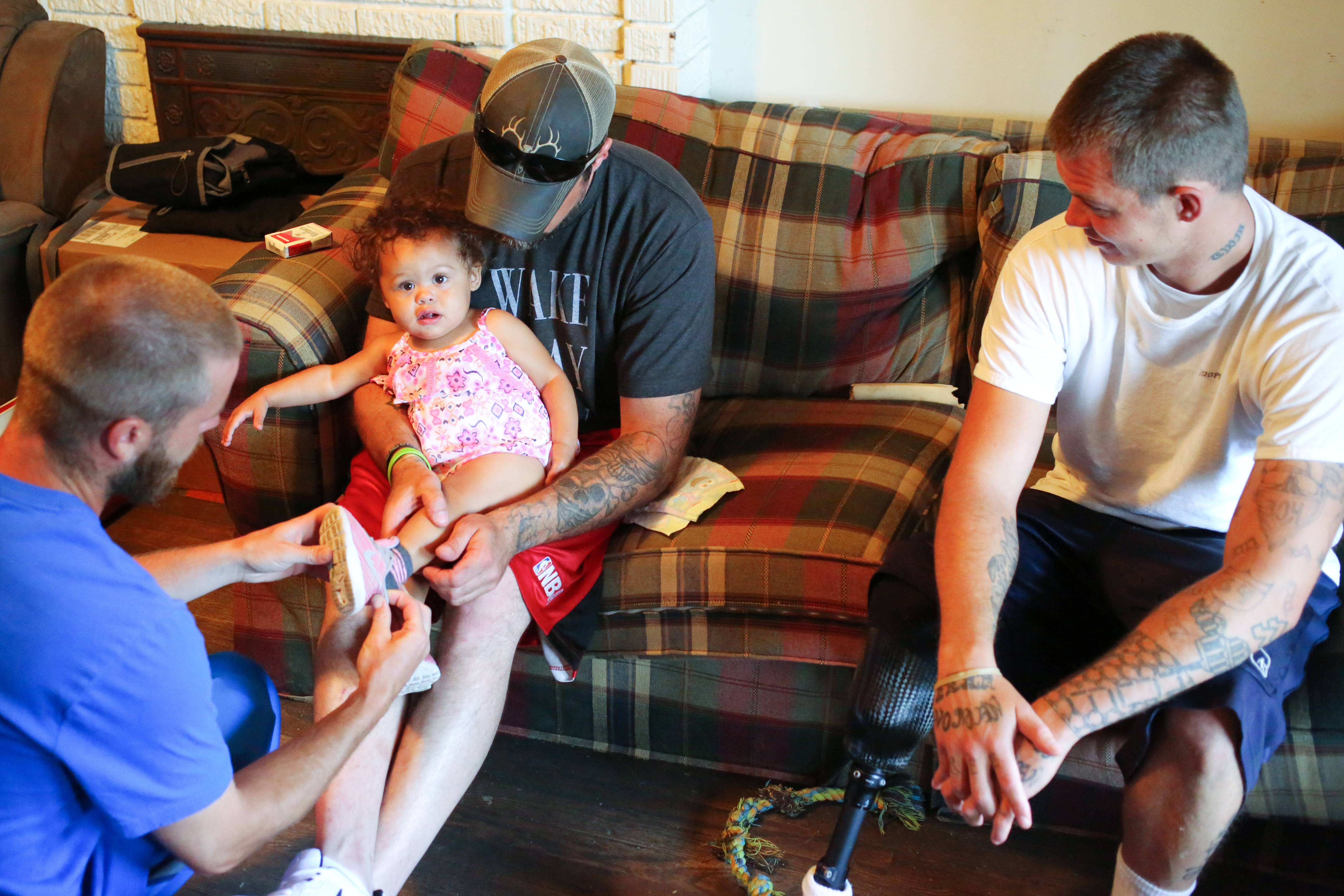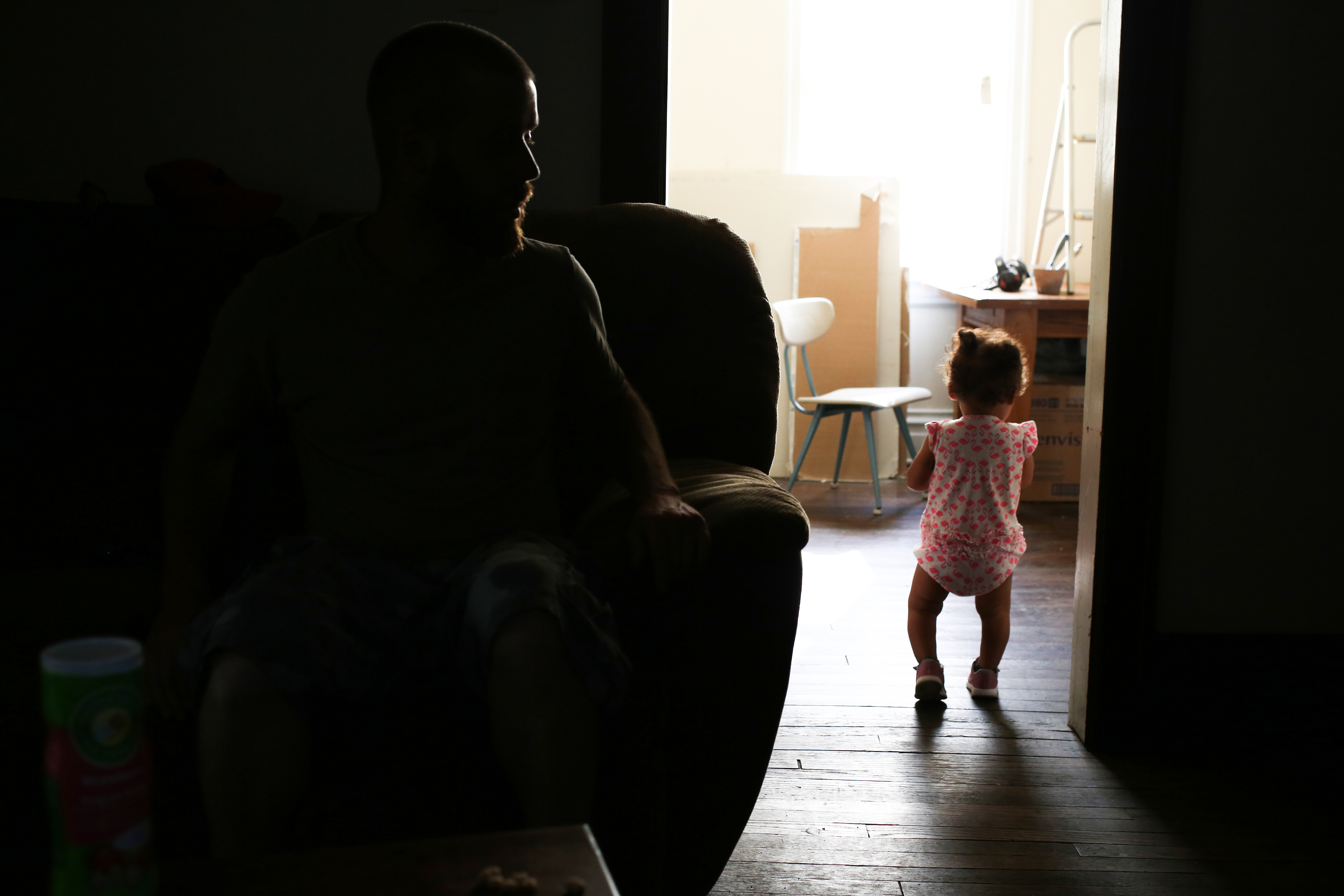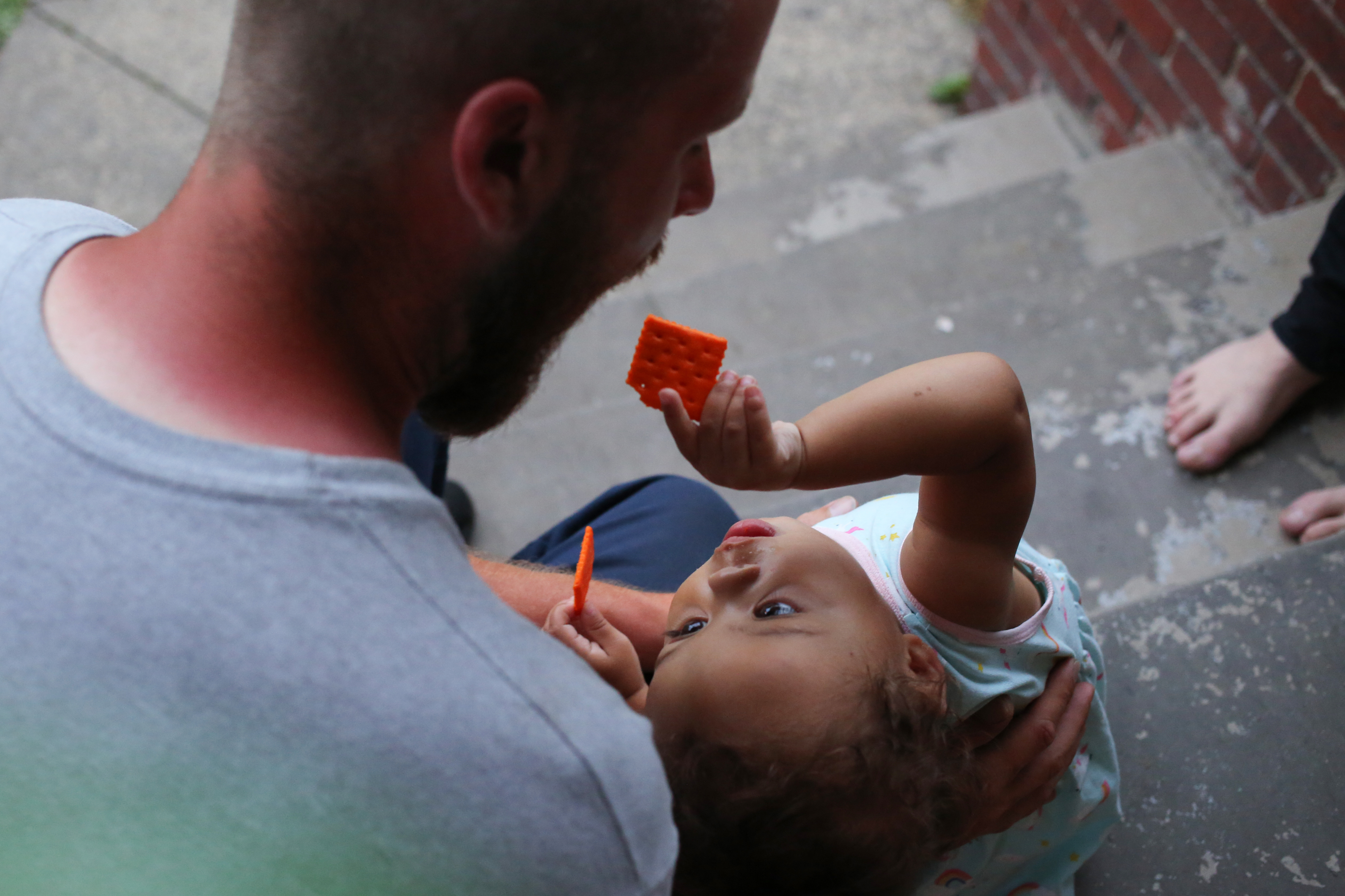Jade runs to the front door as daylight gently washes the dim foyer through large window panes. The toddler peers out the glass, her eyes beaming with wonder as if she is waiting for someone to come and see her.
She scurries back to the cool, dark living room, where her father and a new friend are talking about life. This is not Jade’s home, but her father once lived here before she was born.
It is May 2018. Matt Thompson has been bringing Jade to visit the house every Sunday for the past few months to visit her many uncles. At the moment, many of them are out working, in meetings or at church, but they will be home to see her later.
This old house is part of Newness of Life, a collection of group homes for recovering addicts in Huntington, West Virginia. It is where Thompson reclaimed his soul and renewed his sense of family. It is where his friend, a recruit named Joey, hopes to start a new chapter in life.
Since Thompson and Jade began visiting, her presence has been uplifting and therapeutic for the men who live here. She reminds them why they are trying to stay clean, for themselves and for their own families.
“I think it showed a lot of guys you could actually get your kids — you could actually be a dad,” he says. “I never thought that would happen, ever, and a lot of people here are trying to get their kids back … so it helps them.”


About 17,000 people died from overdose deaths nationwide in 1999, according to the Centers for Disease Control and Prevention. That number had doubled by 2008, and it peaked last year at more than 70,200–about four times as many deaths in 20 years. The U.S. life expectancy also declined for the third year in a row. Overdose deaths and suicides were the leading causes.
These staggering numbers mean the problem has only been getting worse. Provisional overdose death estimates suggest there may have been a slight drop in the 12-month period ending in April this year, but whether it is a sign of hope is too soon to tell.
Addiction is a mental illness, and, despite a long history of drug abuse throughout the world, no one so far has found a single solution for it. Suboxone and methadone are not solutions to addiction; they are solutions to death. The drugs on the street are also becoming more powerful.
Jesus works for some people, but not all. While faith helped Newness of Life’s executive director, Justin Ponton, regain control of his life, he realizes it might not do the same for everybody. That is what makes his approach different from a lot of the other programs in Huntington.
“Justin does an excellent job of creating an environment where people can deal with their addiction and provide them with a framework or a blueprint to get better,” says Huntington Fire Chief Jan Rader, whose department responds to all overdoses in the city of Huntington. “I think that’s part of the battle. He obviously is living proof that you can recover and be successful, and that example is much needed in the recovery community.”
Members are required to go to regular meetings, most of which are faith-based 12-step programs, but Ponton says he doesn’t care as much about how people recover as long as they actually do recover.
“Over the course of this journey, I’ve come to realize that there’s many different ways,” he says. “I just believe any opportunity that helps to sustain life throughout the process to recovery and complete abstinence is just a beautiful thing.”
One of the most important accomplishments is developing a routine with gainful employment, which is something hard to find for recovering addicts, and members must rely on the familial bonds they develop while living together. Whether they choose to believe in God is up to them.
 Upon arriving at Newness of Life for a visit on May 26, Matt Thompson takes off Jade’s shoes as he carries a conversation with Newness of Life members B.J. Thompson, center, and Terry Martin.
Upon arriving at Newness of Life for a visit on May 26, Matt Thompson takes off Jade’s shoes as he carries a conversation with Newness of Life members B.J. Thompson, center, and Terry Martin.
Thompson never made many of the meetings because of work – pretty much the only valid excuse a member could have to miss one–but tried having faith. He says it was not helpful for him.
As somewhat of an introverted person, building accountability and trust with others in the house was a big step forward, something that had not happened in other programs. Newness of Life also taught him how to manage his finances and plan for the future.
His first conversation with house manager Kevin Bowman about moving into the house set those expectations and made him think he had a chance after all. He says that is what changed his attitude about whether he was worthy or capable of getting better.
“They pushed me more than any other program to be productive,” says Thompson, who felt valued for once because the leaders believed in him. “That’s what helped me, knowing that somebody actually cared about me.”
Thompson has known Ponton for about two years, since he arrived in Huntington. Originally from Princeton, West Virginia, about two and a half hours southeast from the city, he came to try the program and ended up living in the house for nearly a year.
Ponton helped Thompson as best he could. Things are better now, but they went through some rough times together. At one point during his recovery, Thompson overdosed and was revived from death when he relapsed.
“I used to cuss him out and talk pure trash to him,” he says. “He’s the only person that showed up.”
 Justin Ponton and his girlfriend, Jami Bamberger, talk to members of Newness of Life in the group home’s backyard on May 13.
Justin Ponton and his girlfriend, Jami Bamberger, talk to members of Newness of Life in the group home’s backyard on May 13.
Ponton himself struggled with drugs, alcohol and crime for about a decade, so he knows many of the things that go through other recovering addicts’ heads. Now 34, he began his personal journey with recovery nearly five years ago after he ended up at the Huntington City Mission with nothing to his name and no one to call.
His parole officer broke through and convinced him that he had something to offer to society, so he started Newness of Life a short time later and has since been trying to do the same for others. His impact on Thompson’s life was so strong that he was the obvious choice to be Jade’s godfather.
Rader says Newness of Life has a good track record with keeping people clean, and it’s even a preferred program in Huntington’s drug court system, but very few of the members actually graduate.
Some get back on their feet, and some move to other group homes because the program here is too difficult. Despite its occasional successes, like Thompson, some unfortunately end up back on drugs, on the streets or in jail.
“We’re the process that begins after the treatment and the rehab.”
“The reason so few do graduate is because the expectations far exceed sobriety in and of itself,” Ponton says. “We’re not a treatment, and we’re not a rehab. We’re the process that begins after the treatment and the rehab.”
The idea of success in recovery is more complex than some might think. Expecting to become fully “cured” is unrealistic because there are currently no scientific cures for addiction. Taking that into consideration, even people who have had success in recovery can relapse.
Addicts never cease to be addicts, so recovery is about striving to overcome an addiction while knowing their desire to get high or drunk will never go away. People make mistakes, and, just as anyone succeeds in life, those who succeed in recovery try to learn from theirs.
In recovery, people must find ways to subvert their addiction by figuring out what success looks like, completing a series of goals to that end and ultimately maintaining status as a productive member of society. That is how most of them get on the right track. Some might be able to quit cold turkey, but success with that is rare.
Carrie Oser, a sociology professor at the University of Kentucky who also serves as interim associate dean in the College of Arts & Sciences, says people who have the most success with recovery are those who have highly personalized treatment plans that are supported by medications for addiction treatment.
One small urge to use, especially combined with some free time and a momentary lack of interpersonal accountability, could be enough to create the perfect drug-induced storm for some people in recovery. What starts as a normal day could easily end in a downward spiral, so recovering addicts always have to stay aware of themselves and wary of their impulses.
“What flips the switch for one person may not flip the switch for another person to relapse.”
“What flips the switch for one person may not flip the switch for another person to relapse,” Oser says. “That’s why having this individually tailored plan that has a variety of wraparound services is helpful.”
 Thompson carries Jade into Newness of Life on May 25.
Thompson carries Jade into Newness of Life on May 25.
Thompson graduated from Newness of Life in March last year, right around the time Jade was born. He paid all his dues and had an apartment lined up, so the leaders of the program let him move out early.
His battle with addiction began when he was 14 years old. To put that into context, the general consensus among scientists about the prefrontal cortex–also known as the decision-making part of the brain–is that it doesn’t fully develop until people are about 25, so he was not capable of making rational decisions when he started using drugs.
Jade’s mother, Janna Riggins, met Thompson about five years ago. She was his drug dealer, using the money she made off him and others to finance her own addiction. Since they broke up in December, he has moved in with Ponton, and she has found a place for herself.
Jade is in Riggins’ custody through the week, and Thompson takes her on the weekends. Both parents have relapsed since graduating from their programs, but Thompson says Riggins has it harder because she gets most of the stress involved with raising a little girl. She also has two older kids who are not in her custody–they live with her parents.
“People say to do it for yourself or whatever, but I more or less do it for my kids.”
“He always knew that I could be better than what I was,” she says, describing their relationship as an somewhat of an emotional support system for their individual paths to recovery. “People say to do it for yourself or whatever, but I more or less do it for my kids.”
 Thompson keeps an eye on Jade as she shuffles into Newness of Life’s dining room on May 25.
Thompson keeps an eye on Jade as she shuffles into Newness of Life’s dining room on May 25.
Thompson will be turning 29 in June, and he cannot believe he has made it this far. He used to joke to friends in high school that he would be lucky to make it to 27. Well, that’s right around the time the old Matt died and a new one was born.
“I never even thought I’d make it this far,” he says. “A lot of times I’m really excited and super happy about it. But also, where I’ve wasted half my life, I also get really, really down on myself.”
When he was about 20, Thompson started sustaining his addiction through theft. Family would give him money at the beginning of the month, but he would be selling stolen items to pawn shops by month’s end because he did not have enough to pay for drugs. He also worked through that time, making quick cash under the table while doing fast food and concessions.
He would get out of jail, do a program and go home clean for a while, but then he would wind up high and go through the cycle all over again. This happened enough times, he says, that he has been in and out of about 14 group homes and recovery programs over the years. His drugs of choice were semisynthetic opioids called Opana and Dilaudid, both of which are several times stronger than morphine.
Newness of Life may have been the one that made a difference for Thompson, but, like all programs, it is not perfect. After all, he has relapsed since he graduated. He also says it’s not for the faint of heart.
The program receives some donations to stay afloat, but members mostly pay rent, utilities and other living expenses out of their own paychecks. They are given daily chores, and they cook, clean and make their own repairs.
“I don’t go to meetings, so this is the only thing I do that helps,” Thompson says. “It lets me see where I was at.”
 Thompson, left, helps Newness of Life members unload a new refrigerator for the program’s home for women on May 26.
Thompson, left, helps Newness of Life members unload a new refrigerator for the program’s home for women on May 26.
While Huntington and other communities around the country have had some success in rallying to support their recovering addicts, a consistent lack of regulation in the pharmaceutical and medical industries has fostered an environment for newer, more potent synthetic opioids to hit the streets.
For example, the Food and Drug Administration recently approved a new type of sufentanil up to 10 times stronger than fentanyl, which was largely responsible for a spike of 26 overdoses in four hours that thrust Huntington into the national spotlight on Aug. 15, 2016.
Local officials have since worried that something even more powerful, like sufentanil, might turn up on the streets at any moment because dealers have increasingly been cutting heroin with fentanyl and other synthetic opioids. According to the West Virginia Health Statistics Center, the state’s rate of overdoses in which synthetic opioids were found between 2010 and 2017 rocketed by nearly 500 percent.
CDC data show West Virginia’s statewide overdose death rate last year was 57.8 per 100,000 people, about 62.5 percent higher than the U.S. rate and the highest of any state. Data provided by the West Virginia Department of Health and Human Resources indicate that the biggest problem is in Cabell County, where Huntington is located.
The number of overdoses in the county nearly doubled between 2015 and 2017 from about 950 to more than 1,800, according to records kept by the Huntington Fire Department. Of those from last year, 183 people died.
While Cabell County’s overdose death rate soared to 153.8 in 2017 from 105.6 in the previous year, The Herald-Dispatch reported in May that the number of overdoses had dropped by 41 percent in the first six months of 2018 compared to the same period last year. The use of naloxone, a narcotic used to revive people from overdoses, had also dropped by 49 percent. Local officials responded to the numbers with optimism.
"This is something everyone in the community has been working together toward," Gordon Merry, director of Cabell County EMS, told The Herald-Dispatch at the time, suggesting that recovery efforts might have been working even though he was not able to provide an exact cause. "I think we're headed in the right direction."
Although his life has significantly improved since he went through the program and relapsed last year, Thompson has had some problems along the way. It’s now November, and his life has drastically changed once again.
Having started seeing another woman this summer, he relapsed a second time around August while he was still living with Ponton. He moved out and almost started another recovery program.
About a month later, Thompson bounced back and took a new job working on a pipeline in Beckley, West Virginia. Bowman from Newness of Life helped him get it. The pay is more than twice the amount he made before in Huntington as a flagger for a paving company, but he is now having a hard time being away from Jade and his support network.
“I want to give her everything that I couldn’t have.”
“I have to tell myself constantly I want to do better,” he says, noting he wants to be the father who Jade needs because he came up in a broken family and lacked guidance. “I want to give her everything that I couldn’t have.”
The new job is supposed to last about two years, but he could get laid off. It also could send him to faraway places like California or Alaska, but he says that is fine by him if he can create a comfortable life for his family.
Ponton fully believes Thompson can accomplish his goals but also worries that he might relapse again, particularly because getting high is so tempting for addicts who are alone with money. And, much like the crisis to which he and many others have fallen victim, Thompson’s modest progress in recovery is simply not enough to quell uncertainty about his future.
“I’m constantly concerned,” Ponton says. “I’m concerned about these people even when everything’s good. We’re all one drink or a drug away from dying.”
 Jade feeds a cracker to Thompson while they are on Newness of Life’s front porch on May 18.
Jade feeds a cracker to Thompson while they are on Newness of Life’s front porch on May 18.
Thompson is not Jade’s biological father. Riggins was already pregnant when they got back together after some time apart, and for a while they did not know whether he was the father. Nevertheless, he eventually decided to adopt Jade as his own. He says he feels a great responsibility toward her, and she gives him reason to live.
Jade even took Thompson’s family name and was listed as his daughter in The Herald-Dispatch’s birth announcements. Love conquers all, and, despite biology, he feels like that makes her his daughter. He sees it no other way.
“I know he always wants the best for me,” Riggins says, asserting that Thompson is a good-natured person and a loving father. “I know if I’m absolutely in a horrible bind, I can count on him even if we weren’t on the best terms.”
Riggins and Jade now do video calls with him as often as they can, and he had some time off to see them around Thanksgiving. He doesn’t get to see Jade much now, but he’s determined to save money for his family’s future. His mom drives up to Huntington from Princeton to help Riggins with Jade when possible.
They may no longer be in a relationship, at least for now, but Thompson and Riggins have remained good friends. Jade doesn’t know it yet, but her mommy and daddy have been stowing a surprise for her over the past couple months–she can expect a pair of siblings in June.
“It took me almost 10 years to get my stuff almost together,” Thompson says, warning that social stigma against addiction is a powerful hindrance to recovery. “It’s so much deeper than saying they’re a junkie or a piece of shit. It’s actually a person.”
If you are struggling with an addiction, someone out there cares about you and wants to help. Please call the Substance Abuse and Mental Health Services Administration’s national helpline at 800-662-4357 to seek treatment options.